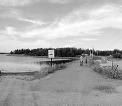Florida Treasure Hunters Researching Information:
Under the 1988 National Marine Sanctuaries Act, anyone who damages or destroys resources in marine sanctuaries is liable for damages. Court documents showed that from January through March, 1992, three vessels working for Fisher’s company, and directed by his son Kane, conducted exploratory treasure-hunting operations in the Florida Keys sanctuary.
The ships employed prop-wash deflectors, 
large pipes placed over the propellers that direct the thrust of the ship’s engines toward the sea bottom in order to displace sediment and expose artifacts. The three ships made more than 600 holes, averaging 20 to 30 feet across and three to five feet deep, in a mile-long area. The test pitting destroyed a total of 1.63 acres of sea grass, a fragile wildlife habitat and an important element of the marine environment. Damaged or destroyed sea-grass meadows may take 50 to 100 years to regrow.
The $589,311 fine was the amount prosecutors sought to recover the costs of damage assessment by the National Oceanic and Atmospheric Administration (NOAA), which manages the marine sanctuaries, and for sea-grass restoration.
Kane Fisher testified during the trial that the treasure hunters failed to employ even minimal standards of archaeological recording. He admitted that the operation was carried out without a research plan and that he had not mapped and recorded the precise locations of artifacts that were removed.
The only setback for the government was the judge’s refusal to fine the treasure hunters for loss of contextual archaeological information and for artifact conservation. The prosecutors had requested an additional $74,830 to cover these costs, but the judge ruled that the loss of contextual data was negligible since the artifacts came from dispersed scatters rather than discrete shipwreck sites. He also ruled that the Sanctuary Act did not entitle the government to curation costs for the artifacts.